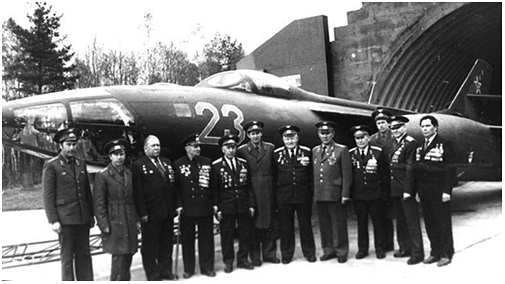Beagle
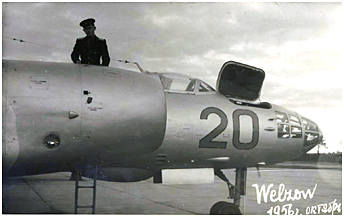 Un Il-28R du 11.ORAP à Welzow en 1956. On notera l'absence de canon du côté droit sous le nez vitré.
© Archives famille V.Bachaev.
Un Il-28R du 11.ORAP à Welzow en 1956. On notera l'absence de canon du côté droit sous le nez vitré.
© Archives famille V.Bachaev.
An Il-28R of the 11.ORAP at Welzow in 1956. One can see that the right gun was not mounted under the glazed nose. © V.Bashaev family archives.
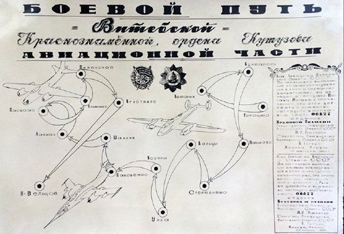 The association of the 11th Vitebsk Red Banner and Kutuzov IIIrd Degree Orders Independent Reconnaissance Aviation Regiment
with Germany and Welzow Airbase extends over the continuous period from July 1954 when the unit settled there until June 1993 when it was retired under the general withdrawal of Soviet-Russian forces from the former GDR.
The 11.ORAP was activated in Goroshchino on August 1, 1942 on the basis of the 3.ODRAE (3 Pe-2 and 8 crews) and the 506.BAP (9 Pe-2 and as many crews), joined in November by the 320.ORAE, bringing the regiment's strength to a total of 28 Pe-2. It was only ten years later, in 1952, that the unit withdrew its Pe-2Rs, replacing them with Ilyushin Il-28Rs.
The regiment with its 32 "Beagles" was relocated in 1954 from Yekabpils in Latvia to Welzow (1).
For some obscure reason, the 886.ORAP had left Altes Lager a few months earlier with its Il-28Rs to be based in Yekabpils.
The 294.ORAP that was based in Welzow since August 1953 had moved to Köthen with its MiG-15Rbis to make way for the newcomers.
The latter unit seemed to have been confused with a training unit by the CIA as evidenced by the report of September 23, 1954,
which also specified that the move to Welzow involved six Li-2 "Cab" and two Yak-14 "Mare" gliders
(> Link).
The association of the 11th Vitebsk Red Banner and Kutuzov IIIrd Degree Orders Independent Reconnaissance Aviation Regiment
with Germany and Welzow Airbase extends over the continuous period from July 1954 when the unit settled there until June 1993 when it was retired under the general withdrawal of Soviet-Russian forces from the former GDR.
The 11.ORAP was activated in Goroshchino on August 1, 1942 on the basis of the 3.ODRAE (3 Pe-2 and 8 crews) and the 506.BAP (9 Pe-2 and as many crews), joined in November by the 320.ORAE, bringing the regiment's strength to a total of 28 Pe-2. It was only ten years later, in 1952, that the unit withdrew its Pe-2Rs, replacing them with Ilyushin Il-28Rs.
The regiment with its 32 "Beagles" was relocated in 1954 from Yekabpils in Latvia to Welzow (1).
For some obscure reason, the 886.ORAP had left Altes Lager a few months earlier with its Il-28Rs to be based in Yekabpils.
The 294.ORAP that was based in Welzow since August 1953 had moved to Köthen with its MiG-15Rbis to make way for the newcomers.
The latter unit seemed to have been confused with a training unit by the CIA as evidenced by the report of September 23, 1954,
which also specified that the move to Welzow involved six Li-2 "Cab" and two Yak-14 "Mare" gliders
(> Link).
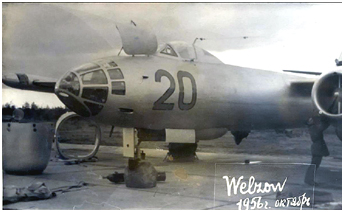
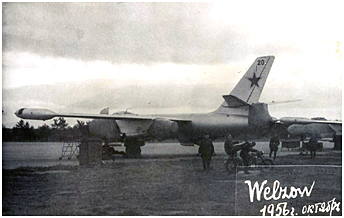 The reconnaissance version of the twin-jet Il-28 flew for the first time on April 19, 1950. Few external differences distinguished it from the bomber version.
The cannon on the right side of the nose was missing (and the supply of ammunition for the remaining gun on the left side was reduced).
However, the main feature that set the IL-28R apart was the addition of two 950-liter fuel tanks at the wingtips (2).
These were often covered with mysterious black panels of different sizes placed in an apparently anarchic manner. This was probably a coating intended to seal fuel leaks.
Moreover, a 750-liter tank also could be placed in the rear of the bomb bay in order to make room for cameras. Standard fuel tank n°3
located in the front upper part of the bomb bay was not present on the reconnaissance version of the "Beagle." Nevertheless, the addition
of the aforementioned tanks finally permitted a range increase from 2580 to a little over 3000 km at 10,000 meters at a cruising speed of 670 km/h (maximum speed was 876 km/h).
The Il-28s were powered by two 2,700 kgp Klimov VK-1 jet engines of the same type used by the MiG-15bis.
The reconnaissance version of the twin-jet Il-28 flew for the first time on April 19, 1950. Few external differences distinguished it from the bomber version.
The cannon on the right side of the nose was missing (and the supply of ammunition for the remaining gun on the left side was reduced).
However, the main feature that set the IL-28R apart was the addition of two 950-liter fuel tanks at the wingtips (2).
These were often covered with mysterious black panels of different sizes placed in an apparently anarchic manner. This was probably a coating intended to seal fuel leaks.
Moreover, a 750-liter tank also could be placed in the rear of the bomb bay in order to make room for cameras. Standard fuel tank n°3
located in the front upper part of the bomb bay was not present on the reconnaissance version of the "Beagle." Nevertheless, the addition
of the aforementioned tanks finally permitted a range increase from 2580 to a little over 3000 km at 10,000 meters at a cruising speed of 670 km/h (maximum speed was 876 km/h).
The Il-28s were powered by two 2,700 kgp Klimov VK-1 jet engines of the same type used by the MiG-15bis.
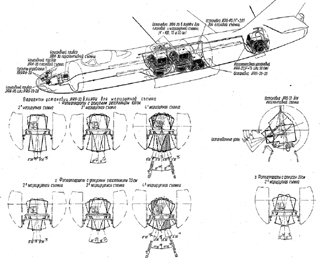
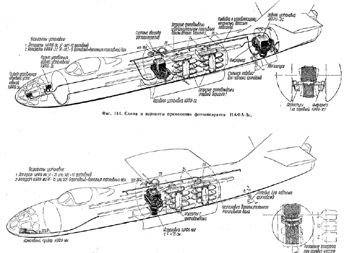 The photographic equipment, distributed between the bomb bay - which had to be opened in flight in order to be able to use the cameras housed inside - and the tail, was heated by hot air taken
from the heating and pressurization system of the cockpit. The cameras were arranged in two different configurations, one intended for daytime reconnaissance, the other for nighttime reconnaissance.
The photographic equipment, distributed between the bomb bay - which had to be opened in flight in order to be able to use the cameras housed inside - and the tail, was heated by hot air taken
from the heating and pressurization system of the cockpit. The cameras were arranged in two different configurations, one intended for daytime reconnaissance, the other for nighttime reconnaissance.
The daytime reconnaissance equipment was composed of four cameras:
- two AFA-33 cameras with a focal length of 500, 750 or 1000 mm (3)
were mounted vertically on AKAFU-33 chassis that could swivel
a few degréés to the left or to the right, were in the forward section of the bomb bay
- a smaller AFA-33 camera with a focal length of 200mm was mounted behind the first two cameras to take wide shots to recognize the
route being taken or realize topographic surveys.
- the rear part of the bomb bay could be occupied by an additional fuel tank of 750 liters.
- a fourth AFA-33 camera with a focal length of 500 or 750 mm was housed in the tail, pointed to the left. It could swivel up to 45 degrees
downwards. The hatch closing the camera bay was located at the bottom of the left side of the fuselage, at the level of the vertical
stabilizer root.
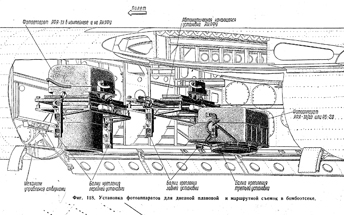
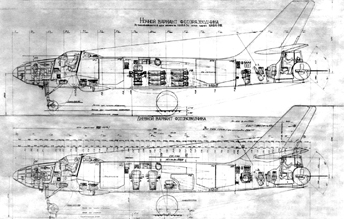 The nighttime reconnaissance equipment was composed of one or two cameras:
The nighttime reconnaissance equipment was composed of one or two cameras:
- the front of the bomb bay was occupied by either a NAFA-3s camera with a focal length of 500 mm,
or either a NAFA-MK camera with a focal length of 500 or 750 mm, both of which could swivel laterally.
- flare bombs necessary for night shots were stored in the bomb bay behind the camera. Twelve FOTAB-50 or SAB-100 flare bombs - or only six when an additional 750 liters fuel tank was
carried - were on board.
- when carrying a NAFA-3s in the bomb bay, a second identical camera was mounted in the tail in a vertical position.
Note also that, in addition to bombs, Il-28 bombers were always likely to carry an AFA-33 camera in front of the bomb bay provided that bomb size or arrangement inside the bomb bay allowed
a camera to be installed.
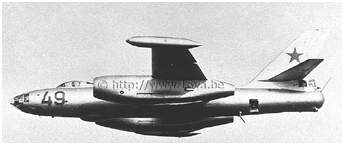
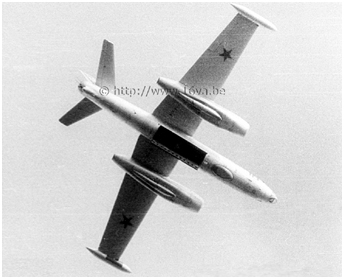 Furthermore, it is certain that other specialized versions of the Il-28 flew alongside the Il-28Rs (and Il-28U "Mascot" training aircraft) of the 11.ORAP.
These aircraft, also delivered to some "fraternal countries," could have been Il-28RTR ELINT variants with wingtip tanks converted into electronic pods with a dielectric
radome to the front and to the rear (> Link). On the other hand, some testimonies report the presence in Welzow
of a separate flight (zveno - OAZ) armed with electronic warfare Il-28PP. They did not have wingtip fuel tanks and a second radome was mounted at the bomb bay location.
These aircraft joined the 65.OBAE in Oranienburg during the summer of 1973 after the disbandment of this flight (see > The target-towing units).
Furthermore, it is certain that other specialized versions of the Il-28 flew alongside the Il-28Rs (and Il-28U "Mascot" training aircraft) of the 11.ORAP.
These aircraft, also delivered to some "fraternal countries," could have been Il-28RTR ELINT variants with wingtip tanks converted into electronic pods with a dielectric
radome to the front and to the rear (> Link). On the other hand, some testimonies report the presence in Welzow
of a separate flight (zveno - OAZ) armed with electronic warfare Il-28PP. They did not have wingtip fuel tanks and a second radome was mounted at the bomb bay location.
These aircraft joined the 65.OBAE in Oranienburg during the summer of 1973 after the disbandment of this flight (see > The target-towing units).
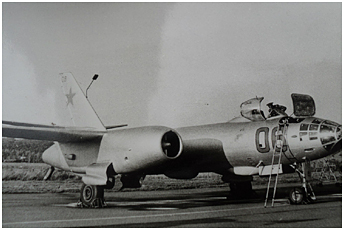
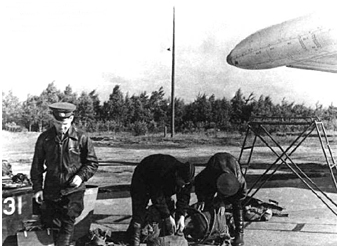 On peut aperçevoir sur cette photo apparemment anodine prise à Welzow entre 1959 et 1961 le bout d'un conteneur caractéristique d'un
Il-28TR de renseignement électronique. © A.P.Telniy/bvvaul-barnaul.narod.ru.
On peut aperçevoir sur cette photo apparemment anodine prise à Welzow entre 1959 et 1961 le bout d'un conteneur caractéristique d'un
Il-28TR de renseignement électronique. © A.P.Telniy/bvvaul-barnaul.narod.ru.
This seemingly innocuous picture taken at Welzow between 1959 and 1961 reveals the wingtip ELINT pod of an Il-28RTR. © A.P.Telniy/bvvaul-barnaul.narod.ru.
The association of the 11.ORAP with the commissioning of East German Il-28s deserves a mention, although historical accuracy is undermined by the lack of
non-contradictory accurate information. The LSK /LV took seven Il-28, two Il-28R and one Il-28U into the inventory. They essentially were used to tow
or drop targets. The first two "Beagle" delivered in June 1959 to the 3.Staffel of JG-1 (Jagdfliegergeschwader) in Cottbus came from the ranks of the
11.ORAP. Logically these aircraft should therefore have been Il-28R (the only Il-28U was delivered in 1961). However, according to the information available,
the two aircraft delivered in 1959 were not reconnaissance variants. On the other hand, personnel of the future target-towing squadron (Zieldarstellungstaffel)
underwent conversion training - theoretical and /or practical? - with the 11.ORAP. The confusion increases when we consider that two Il-28R served as flying
test beds for the "Pirna" reactor destined for the East German "152" (Baade 152) airliner project. The first aircraft arrived in the spring of 1958, the second
one in 1959. Two hundred eleven test flights were carried out between September 1959 and June 1961. These aircraft subsequently were transformed into target tugs
and transferred to the LSK /LV where they flew using the coded designators "180" and "184."
| ORBAT 1945 - 1993 |
Mangrove & Brewers
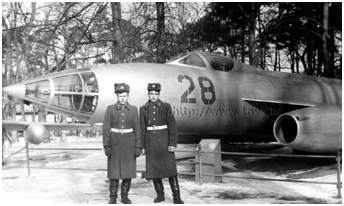
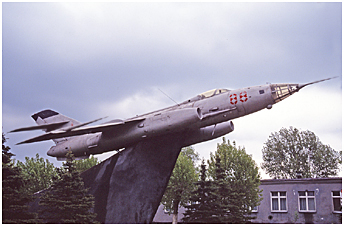 In 1966, two years before the Il-28 withdrawal, the third squadron of the 11.ORAP received Yak-27R "Mangrove" reconnaissance aircraft.
The superior performance of the new aircraft made it possible to use the cameras in a supersonic flight regime. It was possible to take pictures
at altitudes up to 16,000 meters at subsonic speed and between 12,000 and 14,500 meters at supersonic speed. However, the Yak-27R had an important
drawback. Missions could only take place during daylight when the visbility was sufficient. The Yak-27R had four photo compartments distributed over
the entire length of the fuselage. Above 1000 meters, the navigator used a PV-2R optical viewfinder protected under a small dome located under the nose
to decide when he could trigger the cameras. The first camera was mounted obliquely right in front of the gun nozzle orifice of the single 23mm NR-23
cannon mounted on the right side of the fuselage. A sliding door protected the compartment of this camera, as well as those of the others. It was not
possible to operate the gun when that photo hatch was open. Another compartment containing a topographic camera was located under the belly behind the
wing trailing edges. Further back, there were two more camera bays with vertical cameras. Camera types included
AFA-42 models with different focal lengths
(varying according to the aircraft odd or even construction numbers). A smaller AFA-41/10
vertical camera was used for small-scale photographs of land strips
from the altitude of 300-400 meters, or to get an overview of the targets from a higher altitude.
In 1966, two years before the Il-28 withdrawal, the third squadron of the 11.ORAP received Yak-27R "Mangrove" reconnaissance aircraft.
The superior performance of the new aircraft made it possible to use the cameras in a supersonic flight regime. It was possible to take pictures
at altitudes up to 16,000 meters at subsonic speed and between 12,000 and 14,500 meters at supersonic speed. However, the Yak-27R had an important
drawback. Missions could only take place during daylight when the visbility was sufficient. The Yak-27R had four photo compartments distributed over
the entire length of the fuselage. Above 1000 meters, the navigator used a PV-2R optical viewfinder protected under a small dome located under the nose
to decide when he could trigger the cameras. The first camera was mounted obliquely right in front of the gun nozzle orifice of the single 23mm NR-23
cannon mounted on the right side of the fuselage. A sliding door protected the compartment of this camera, as well as those of the others. It was not
possible to operate the gun when that photo hatch was open. Another compartment containing a topographic camera was located under the belly behind the
wing trailing edges. Further back, there were two more camera bays with vertical cameras. Camera types included
AFA-42 models with different focal lengths
(varying according to the aircraft odd or even construction numbers). A smaller AFA-41/10
vertical camera was used for small-scale photographs of land strips
from the altitude of 300-400 meters, or to get an overview of the targets from a higher altitude.
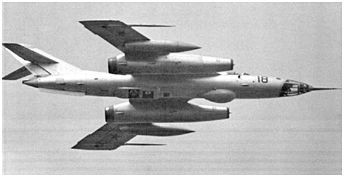
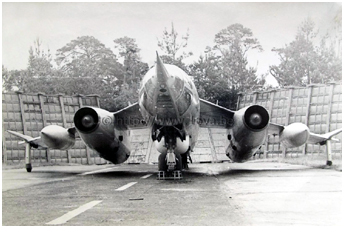 The career of the Yak-27R in the 11.ORAP was short-lived because, in 1970, the Yak-28PP "Brewer-E" electronic warfare aircraft replaced the "Mangrove"
in the third squadron. In 1968, the Yak-28R "Brewer-D" already had replaced the IL-28R in the first and second squadrons. The Yak-28R, production of which
had started in Irkutsk in 1966, was developed on the basis of the Yak-28I "Brewer-C" tactical bomber. This new version in the Yak-25/26/27/28 family effectively
ended the career of the last Il-28R and Yak-27R in the Soviet VVS. Although derived from a bomber, this model no longer had a bomb bay. Instead, three compartments
for reconnaissance equipment were placed within the mid-fuselage where the original bomb bay was located. The Initsiativa-2 (Initiative) bombing and mapping
radar of the Yak-28I was retained, but in a modified -2R variant, later replaced by the Initsiativa-3 radar specially developed for the Yak-28R.
The GSh-23Ya twin gun of the "Brewer-C" was not retained.
There were five different reconnaissance suites for the Yak-28R comprising:
The career of the Yak-27R in the 11.ORAP was short-lived because, in 1970, the Yak-28PP "Brewer-E" electronic warfare aircraft replaced the "Mangrove"
in the third squadron. In 1968, the Yak-28R "Brewer-D" already had replaced the IL-28R in the first and second squadrons. The Yak-28R, production of which
had started in Irkutsk in 1966, was developed on the basis of the Yak-28I "Brewer-C" tactical bomber. This new version in the Yak-25/26/27/28 family effectively
ended the career of the last Il-28R and Yak-27R in the Soviet VVS. Although derived from a bomber, this model no longer had a bomb bay. Instead, three compartments
for reconnaissance equipment were placed within the mid-fuselage where the original bomb bay was located. The Initsiativa-2 (Initiative) bombing and mapping
radar of the Yak-28I was retained, but in a modified -2R variant, later replaced by the Initsiativa-3 radar specially developed for the Yak-28R.
The GSh-23Ya twin gun of the "Brewer-C" was not retained.
There were five different reconnaissance suites for the Yak-28R comprising:
- Two AFA-54 cameras with a focal length of 750 or 1000mm installed on swiveling mounts and a fixed
AFA-42/20 camera for
low-level photography;
- Suite comprising an AShchAFA-8 camera (4) for continuous photography and an AFA-42/20 camera;
- Suite comprising an AFA-41/10 camera with a TAU-M gyro stabilization system for topographic photography from medium and
high altitude;
- Suite comprising an NAFA-Ya7 camera and a SOU-2 flash for night photography;
- Suite comprising a Romb-4A (Rhombus) ELINT system capable of receiving radar signals out to a range of 365 km from an altitude
of 10 kilometers
(250 km from 4000 meters) within a 50º radius (the dielectric panels seemed to be located on each side of the fuselage
tailcone).
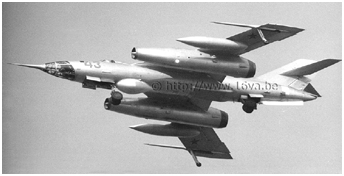
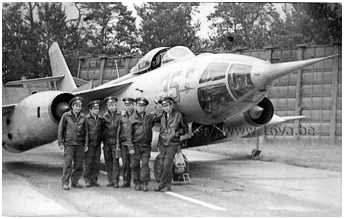 Some "Brewer-D" were equipped with a TARK-1 (Televizionnyy Aviatsionnyy Razvedyvatel'nyy Kompleks) airborne television reconnaissance complex comprising TV
cameras and a data link for real-time transmission of images to a ground station. The transmitting antenna was located under the Initsiativa radar fairing
that was not mounted on this Yak variant. A camera with a focal length of 190mm also was carried. This version was designated Yak-28RL.
It is not excluded that other versions derived from the Yak-28R also flew with the 11.ORAP. A version of the Yak-27/-28 family designated Yak-28RR (Radiatsionnaya Razvedka)
carried special pods used for measuring the levels of radioactivity in the air instead of external fuel tanks. These pods, designated
RR8311-100 or Fuka (> Photo), resembled rocket pods.
However, the Yak-28RR designation was misleading as it was not a version of the Yak-28R, but of the
Yak-28L "Brewer-B" tactical bomber. About ten Yak-28L would have been converted for this task in the mid-sixties.
This variant was positively identified within the 931.OGRAP at Werneuchen (see this > Photo).
This type of pod was originally developed for the Yak-28; however it eventually was adapted to many aircraft types as varied as the An-12, Tu-16 or Su-27.
Of course, the 11.ORAP also had some two-seater Yak-28U "Maestro" training and conversion aircraft within its ranks.
Some "Brewer-D" were equipped with a TARK-1 (Televizionnyy Aviatsionnyy Razvedyvatel'nyy Kompleks) airborne television reconnaissance complex comprising TV
cameras and a data link for real-time transmission of images to a ground station. The transmitting antenna was located under the Initsiativa radar fairing
that was not mounted on this Yak variant. A camera with a focal length of 190mm also was carried. This version was designated Yak-28RL.
It is not excluded that other versions derived from the Yak-28R also flew with the 11.ORAP. A version of the Yak-27/-28 family designated Yak-28RR (Radiatsionnaya Razvedka)
carried special pods used for measuring the levels of radioactivity in the air instead of external fuel tanks. These pods, designated
RR8311-100 or Fuka (> Photo), resembled rocket pods.
However, the Yak-28RR designation was misleading as it was not a version of the Yak-28R, but of the
Yak-28L "Brewer-B" tactical bomber. About ten Yak-28L would have been converted for this task in the mid-sixties.
This variant was positively identified within the 931.OGRAP at Werneuchen (see this > Photo).
This type of pod was originally developed for the Yak-28; however it eventually was adapted to many aircraft types as varied as the An-12, Tu-16 or Su-27.
Of course, the 11.ORAP also had some two-seater Yak-28U "Maestro" training and conversion aircraft within its ranks.
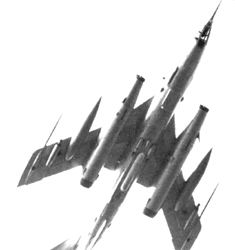
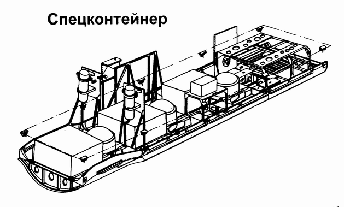 Schéma du module rétractable rempli d'équipements de CME qui occupait la soute à bombes des Yak-28PP. © DR.
Schéma du module rétractable rempli d'équipements de CME qui occupait la soute à bombes des Yak-28PP. © DR.
Sketch of the retractable module filled with ECM equipments that fitted the Yak-28PP bomb bay. © DR.
After the first and second squadrons were reequipped with Yak-28R from 1968 on and replacement of Yak-27R in the third squadron by Yak-28PP in 1970,
the 11.ORAP therefore was equipped only with Yak-28s. While the regiment certainly has employed some electronic warfare aircraft during the Il-28 period,
establishment of a full Yak-28PP (PP for Postanovshchik Pomekh - Jammer) squadron clearly announced that the regiment was a composite reconnaissance
and electronic warfare unit.
To mix reconnaissance and electronic warfare aircraft in the same regiment was not surprising. The easy maintenance of two nearly identical airframes
was an obvious reason. On the other hand, reconnaissance aircraft had to identify the threats on the penetration axes along which the attack aircraft
protected by Yak-28PP would fly.
The "Brewer-E" was series produced in Irkutsk from 1970 on and consequently the 11.ORAP quickly took into its inventory
a new aircraft dedicated to the protection of bomber formations over the battlefield. In order to jam enemy radars, the Yak-28PP
carried an electronic countermeasures suite that included the Buket (Bouquet) and the SPS-5/M Fasol'-1 (Kidney Bean).
These jammers were available in different versions in order to cover different frequency bands. Thus, several aircraft equipped with different jammer versions
could fly together to counter any threat when that was deemed necessary. The Buket variants carried by the Yak-28PP were
SPS-22, SPS-44 and SPS-55 models. There were four different versions of the Fasol'-1.
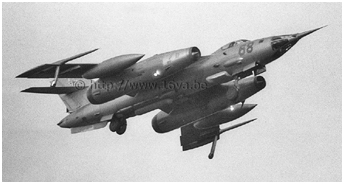
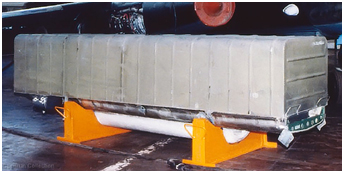 Le module rétractable rempli d'équipements de CME qui occupait la soute à bombes des Yak-28PP recouvert de son écran protecteur. © DR.
Le module rétractable rempli d'équipements de CME qui occupait la soute à bombes des Yak-28PP recouvert de son écran protecteur. © DR.
This retractable module filled with ECM equipments that fitted the Yak-28PP bomb bay was covered by a protective screen. © DR.
A retractable module that had to be lowered to the ground and removed for any maintenance or inspection replaced the former bomb bay. It was not possible to access
the equipment bay without lowering the module so changing the jammer variants for specific missions was time consuming. Fortunately, interchangeable modules
became available beginning with the fourth production batch.
The ECM suite housed inside the module included the Fasol'-1 and Buket jammers - the antennas of the latter were housed under a long prominent fairing
located under the equipment bay. The special trolley used to move the module had a protective screen that fit around the shape of that fairing. It had been designed to operate the
Buket on the ground while protecting personal from the powerful microwaves generated by the system that were then transformed into heat.
There also was an antenna for the SPS-5 jammer under each engine nacelle.
The vacuum tube electronics generated considerable heat and they had to be cooled, hence presence of three
ventral air intakes (two heat exchangers and one air scoop) under the center fuselage forward of the equipment bay.
The Yak-28PP also had passive
jamming systems. Thus, two UB-16-57UM rocket pods attached to BD3-60-21UM pylons could be mounted outboard of the external fuel tanks. They
held sixteen S-5P rockets filled with fiberglass dipoles coated with metal. Once fired, these rockets exploded in front of the plane, deploying a cloud of decoys
that created a radar echo.
An Avtomat-2I ASO-2I flare launcher system ensured that the aircraft were protected against radar and IR-guided missiles. Flares could be fired manually or automatically
via an SPO-3 Sirena-3 (Siren) radar homing and warning receiver. The KDS-19 cassettes containing the flares were mounted under the engine
nacelles.
Also, a Siren' (Lilac) complex ensured aircraft protection by returning false radar echoes to disrupt firing radars. Here also, the
Siren' complex comprised several versions: SPS-141, -142 and -143. Its electronics occupied the former gun bay of the GSh-23Ya cannon on the right side of the nose.
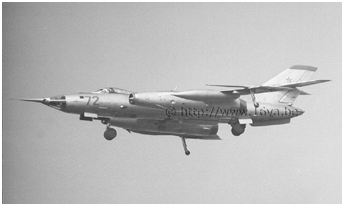
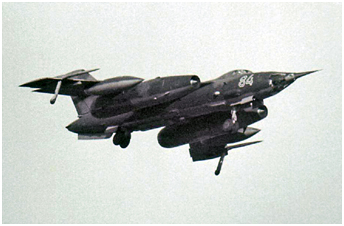 Yak-28R and Yak-28PP were the "Brewer" variants that remained in service for the longest time, including in the GDR.
Besides the importance of this type of aircraft in the Soviet military arsenal, it seems that their reliability was not unrelated to that.
The Yak-28PP were transferred to Werneuchen in June 1986, where for a few months they formed the second squadron of the 931.OGRAP. Also in June 1986, the last
931.OGRAP Yak-28R moved to Welzow, where they took the place vacated by the departure of the "Brewer-E." The 11.ORAP had thus lost its electronic
warfare squadron. This was only a temporary loss, as replacements for the Yak-28PP, namely Su-24MP "Fencer-F," landed at Welzow in 1989. All
Yak-28R still present in the GDR had thus been concentrated within the 11.ORAP for their imminent departure from Germany. In the meantime, their
successors, new Su-24MR "Fencer-E," had arrived at Welzow from where they flew their first operational sorties in February 1986. The last fourteen
Yak-28R of the 11.ORAP definitely left the GDR on July 2 of that year.
Yak-28R and Yak-28PP were the "Brewer" variants that remained in service for the longest time, including in the GDR.
Besides the importance of this type of aircraft in the Soviet military arsenal, it seems that their reliability was not unrelated to that.
The Yak-28PP were transferred to Werneuchen in June 1986, where for a few months they formed the second squadron of the 931.OGRAP. Also in June 1986, the last
931.OGRAP Yak-28R moved to Welzow, where they took the place vacated by the departure of the "Brewer-E." The 11.ORAP had thus lost its electronic
warfare squadron. This was only a temporary loss, as replacements for the Yak-28PP, namely Su-24MP "Fencer-F," landed at Welzow in 1989. All
Yak-28R still present in the GDR had thus been concentrated within the 11.ORAP for their imminent departure from Germany. In the meantime, their
successors, new Su-24MR "Fencer-E," had arrived at Welzow from where they flew their first operational sorties in February 1986. The last fourteen
Yak-28R of the 11.ORAP definitely left the GDR on July 2 of that year.
notes
(1)
Also known as Neu-Welzow or Spremberg.
(2)
Il-28T torpedo planes of the Navy also were equipped with wingtip tanks.
On the other hand, some IL-28R were converted into target tugs (see > The target-towing units).
(3)
The focal lengths are expressed in centimeters in the Soviet technical nomenclature. Thus, an AFA-33/50 camera has a focal length of 50 cm.
(4)
This type of camera was initially developed in the USSR in 1936. It was used to photograph the ground passing under the plane continuously
through a rectangular opening (general layout > here).
The contact sheet obtained looked like a continuous mosaic picture. The camera body in
principle comprised two different lenses that made it possible to obtain the same image in two different scales at the same time.
 |
11.ORAP > Part 2 |
 |
Plan du site - Sitemap |  |

